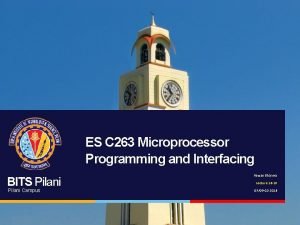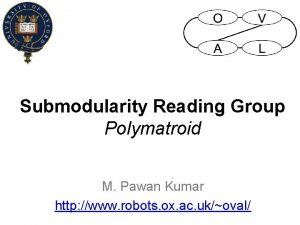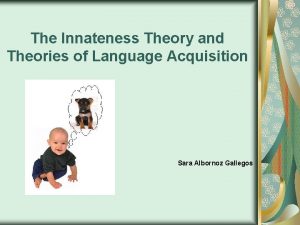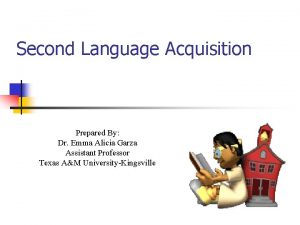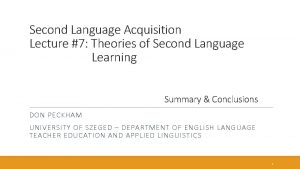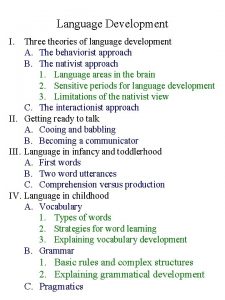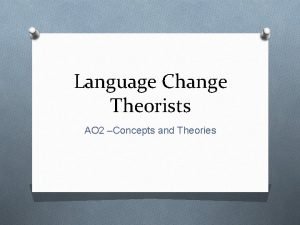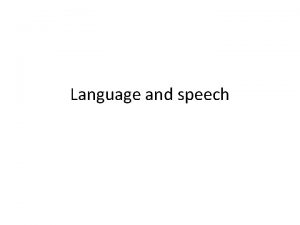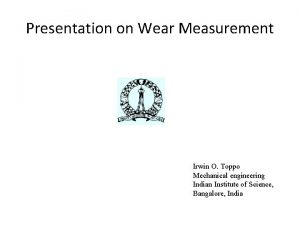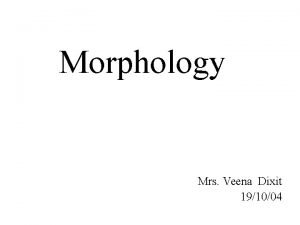THEORIES OF LANGUAGE DEVELOMENT SAUSSURES THEORY PAWAN TOPPO








- Slides: 8

THEORIES OF LANGUAGE DEVELOMENT: SAUSSURE’S THEORY PAWAN TOPPO B. ED, 1 st SEMESTER DEROZIO HOUSE ROLL NO-24 B. T & EVENING COLLEGE(B. ED SECTION)

THEORITICAL PERSPECTIVE OF ALNGUAGE� 1. LANGUAGE AS SOCIAL FACT (SAUSSURE’S CONCEPT) � 2. LANGUAGE AS BEHAVIOUR (BLOOMFIELD’S CONCEPT) � 3. LANGUAGE AS MENTAL ORGAN (CHOMSKY’S CONCEPT) � 4. LANGUAGE AS ABSTRACT OBJECT ( J KATZ’S CONCEPT)

LANGAUGE AS SOCIAL FACT: �IT’S PROPOUNDED BY SWIS LINGUISTS FERDINAND DE SAUSSURE �IT’S STUDY OF LANGUAGE AS A SYSTEM AT THE CURRENT STAGE OF IT’S DEVELOPMENT �IT’S MAIN AIM WAS TO INVESTIGATE LANGUAGE FROM THE POINT OF VIEW OF IT’S USERS �FOCUSED ON STRUCTURE OF LANGUAGE AND COMPARISON WITH CHASE BOARD �HE SUGGESTED THAT LANGUAGE IS A SOCIAL FACT AKIN TO OTHER SOCIAL INSTITUTIONS e. g THE LEGAL SYSTEM OR DRESS CODE

SASSURE’S THEORIES OF LANGUAGE: �FERDINAD DE SAUSSURE(1857 -1913) known as one of the founders of contemporary linguistics and as the Father of European Structuralism. His lectures were compiled by his students as COURSE IN GENERAL LINGUSTICS(1983). q. LANGUE/PAROLE: Langue(language) is system of language & Parole(speaking) is individual utterance. �Example- Bengali(Langue) & it’s variation in speaking e. g. Ram’s Bengali or Shyam’s Bengali(Parole) �According to him it’s necessary to distinguish the underlying system (langue) from the individual representation(parole)

DIACHRONIC/SYNCHRONIC: �DIACHRONIC is the evaluation of language or historical study of language. �SYNCHRONIC is a snapshot of language at a particular time. �Example- A Chair in it’s present situation would be Synchronic & the evaluation how the chair is made(treewood-chair), would be Diachronic. �Saussure differentiates between the diachronic and synchronic and suggested that synchronic is the proper object of study in general linguistics.

SIGNIFIER/SIGNIFIED: �He argued that ‘sign’ is composed of two faces : ‘signifier’(sound image) and ‘signified’(concept). Example- Cat: The sound image of the word Cat is Signifier and the concept of the word Cat as an animal is Signified. Ø There is no natural connection between signifier(sound image) and signified(concept). Ø Language users connect signifiers and signified in an arbitrary way. Ø The relationship between signifier and signified is Binary oppositional (black is black because it’s not white)

PARADIGMATIC/SYNTAGMATIC : �Paradigmatic- that is according to the membership in particular types or classes of sign. �Syntagmatic - that is according their position in given sentence or utterance. �According to Saussure linguistic signs are linked together either paradigmatically or syntagmatically.

REFERENCE: �Dinda, Dr. Malayendu. Language Across The Curricualm; Rita Publication; 2015 �Berry, Peter. Beginning Theory; Viva Books; 2015
